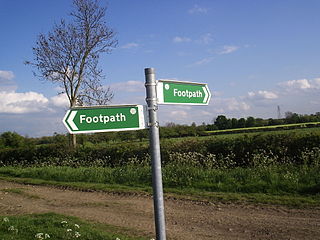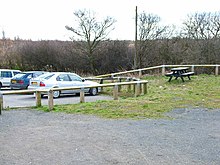Eminent domain, land acquisition, compulsory purchase, resumption, resumption/compulsory acquisition, or expropriation is the power of a state, provincial, or national government to take private property for public use. It does not include the power to take and transfer ownership of private property from one property owner to another private property owner without a valid public purpose. This power can be legislatively delegated by the state to municipalities, government subdivisions, or even to private persons or corporations, when they are authorized by the legislature to exercise the functions of public character.

The Wildlife and Countryside Act 1981 is an Act of Parliament in the United Kingdom implemented to comply with European Council Directive 79/409/EEC on the conservation of wild birds. In short, the act gives protection to native species, controls the release of non-native species, enhances the protection of Sites of Special Scientific Interest and builds upon the rights of way rules in the National Parks and Access to the Countryside Act 1949. The Act is split into 4 parts covering 74 sections; it also includes 17 schedules.

The Transport Act 1962 is an Act of the Parliament of the United Kingdom. Described as the "most momentous piece of legislation in the field of railway law to have been enacted since the Railway and Canal Traffic Act 1854", it was passed by Harold Macmillan's Conservative government to dissolve the British Transport Commission (BTC), which had been established by Clement Attlee's Labour government in 1947 to oversee railways, canals and road freight transport. The Act established the British Railways Board, which took over the BTC's railway responsibilities from 1 January 1963 until the passing of the Railways Act 1993.

In England and Wales, excluding the 12 Inner London boroughs and the City of London, the right of way is a legally protected right of the public to pass and re-pass on specific paths. The law in England and Wales differs from Scots law in that rights of way exist only where they are so designated, whereas in Scotland any route that meets certain conditions is defined as a right of way, and in addition, there is a general presumption of access to the countryside. Private rights of way or easements also exist.
The Locomotive Acts were a series of Acts of Parliament in the United Kingdom regulating the use of mechanically propelled vehicles on British public highways during the latter part of the 19th century.

The Office of Rail and Road (ORR) is a non-ministerial government department responsible for the economic and safety regulation of Britain's railways, and the economic monitoring of National Highways.
A parish meeting is a meeting all the electors in a civil parish in England are entitled to attend.

The London Government Act 1899 was an Act of the Parliament of the United Kingdom that reformed the administration of the capital. The Act divided the County of London into 28 metropolitan boroughs, replacing the 41 parish vestries and District Boards of Works administering the area. The legislation also transferred a few powers from the London County Council to the boroughs, and removed a number of boundary anomalies. The first elections to the new boroughs were held on 1 November 1900.
The Epping Forest Keepers are an ancient and historic body of people who are employed by the City of London, who in return are responsible, on behalf of the Conservators, for the management and care of Epping Forest, which covers approximately ten square miles of forest, bridleway, woodland and recreational space stretching from Forest Gate in east London, north to North Weald in Essex. The forest is managed by the City of London Corporation and is one of many open spaces that comes under their control that is outside the Square Mile that are maintained by the Corporation of London at no expense to the taxpayer.

The Town and Country Planning Act 1990 is an act of the United Kingdom Parliament regulating the development of land in England and Wales. It is a central part of English land law in that it concerns town and country planning in the United Kingdom. Repealed in parts by the Planning and Compensation Act 1991, it is now also complemented by the Planning and Compulsory Purchase Act 2004.

The Road Traffic Regulation Act 1984 is an Act of Parliament in the United Kingdom, which provided powers to regulate or restrict traffic on UK roads, in the interest of safety. It superseded some earlier legislation, including the majority of the Road Traffic Regulation Act 1967. The Act is split into 10 parts covering 147 sections, it also includes 14 schedules.
The history of fire safety legislation in the United Kingdom formally covers the period from the formation of the United Kingdom of Great Britain and Ireland in 1801 but is founded in the history of such legislation in England and Wales, and Scotland before 1708, and that of the Kingdom of Great Britain from 1707 to 1800.

The Traffic Management Act 2004 is an Act of the Parliament of the United Kingdom. It sets out how road networks should be managed by local authorities and includes regulations for roadworks. The Act has been implemented from 1 April 2008 across the United Kingdom.

An Act of Parliament in the United Kingdom is primary legislation passed by the UK Parliament in Westminster, London.
In the United Kingdom, byelaws are laws of local or limited application made by local councils or other bodies, in specific areas using powers granted by the relevant Acts of Parliament, and so are a form of delegated legislation. Some byelaws are also made by private companies or charities that exercise public or semi-public functions, such as airport operators, water companies or the National Trust.

The Director of Public Transport was the head of the Public Transport Division (PTD) of the Victorian Department of Transport. PTD was the government agency responsible for promoting, providing, coordinating and regulating public transport in the state of Victoria, Australia between August 1999 and June 2013. The Director of Public Transport was created as a statutory office supported by staff of the Department of Transport.

The Protection of Freedoms Act 2012 is an Act of the Parliament of the United Kingdom. As the Protection of Freedoms Bill, it was introduced in February 2011, by the Home Secretary, Theresa May. The bill was sponsored by the Home Office. On Tuesday, 1 May 2012, the Protection of Freedoms Bill completed its passage through Parliament and received royal assent.

The Petroleum (Consolidation) Act 1928 is a UK Act of Parliament to consolidate the enactments relating to petroleum and petroleum-spirit. It specified and updated the conditions for the granting of licenses for keeping petroleum spirit; the labelling of containers for petroleum spirit; its transport; and regulations for certain uses.
The Electric Lighting Acts 1882 to 1909 are acts of the Parliament of the United Kingdom.














